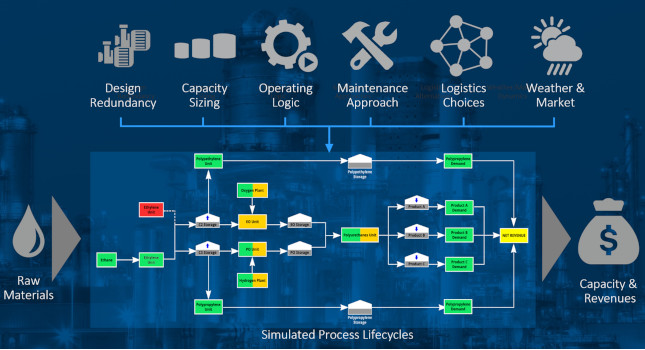Improving asset criticality with better decision making at the plant level
KPIs express and protect the license to operate, which include safety, environmental, and compliance protections
Plant managers making complex decisions daily that impact an organization’s bottom line and asset criticality. It begins with the Key Performance Indicators (KPIs) that define the operating performance of a manufacturing plant – the handful of key levers that ultimately control the business operation and lead financial performance. They can be separated into two clusters. First, the KPIs that express and protect the license to operate, which include safety, environmental, and compliance protections. If those aren’t done successfully, a manufacturer may not be allowed to operate. Figure 1 dashboard shows the critical KPIs for a manufacturing plant.

Figure 1: Dashboard that shows the critical KPIs for a manufacturing plant. Courtesy: AspenTech
The second cluster is all about the efficiency and optimal performance of the manufacturing operation:
- Equipment Availability – the percentage of time required to run the equipment
- Energy Consumption – the amount of energy used to support the equipment availability
- High value product – the volume/value of product made with the availability and energy
These KPIs are very general, sometimes expressed in similar ways, and can support any type of manufacturing. From oil processing to chocolate making, to minivan production. Notwithstanding the earnestness in protecting the license to operate, this paper is focused on the pure operating performance aspects. In that respect, one can assert that equipment availability will always be the most important, because if equipment is not running, the energy and production have no consequence or bearing on performance.
To put it simply, a manufacturing process takes raw material(s) and adds energy, in a regular, ordered process, to manufacture the product(s). However, there are elements that can encourage or constrain the time, efficiency and ultimately the profitability of the process. Decisions on how the process is planned, scheduled, and operated play a major part, and external influences can impart negative consequences. They can be seen in Figure 2, indicating the process steps from raw materials to products in the example of an integrated chemical manufacturing site.

Figure 2: Process steps from raw materials to products for an integrated chemical manufacturing site. Courtesy: AspenTech
The process is designed up front and put in place with certain built-in constraints such as redundancy of equipment, the capacity of equipment / trains / units and of intermediate and final storage. Many items are adjustable, such as the operating logic, plans, scheduling and the approach to maintenance and logistics choices, such as shipping methods. However, some items that affect performance, such as market volatility, weather, logistics and shipping, are not predetermined. All these factors influence the ultimate plant performance and profitability. Some of the most significant factors are about the mechanical equipment and availability to the operating plant. Equipment can fail or wear out, causing interruptions to production. Any time equipment is out for service maintenance, it can mean significant losses in production, which could amount to exponentially more than the cost of the maintenance and repairs.
Decision making for asset criticality
With all of this in mind, there are many decisions to be made all the time about assets, performance limits and thresholds, maintenance strategy and timing, reliability expectations, and so on. In the past, decisions on asset criticality or risk analysis were unsubstantiated, with little to no mathematical methodology behind them. This is because analysis considered criticality and risk based on an isolated machine. However, every machine operates within the context of a process, and in relation to other machines. Manufacturing companies cannot separate the machine from the process, or the process from the machine, and they certainly should not be basing decisions on one machine in isolation.
Previously, it was also common for decisions to be made based on the greatest reliability, which is not necessarily the optimum strategy. The most critical items may not only be what causes the greatest production interruption when they do fail. Critical items may not appear as important at first, so a more thorough assessment is needed to uncover them. In the end, the goal of criticality assessments is to set up the appropriate maintenance strategy for when and how to do inspections, service and repair. If the underlying assumptions are incorrect, then what about the outcomes? Today, we can change this.
The prior approach to determining asset criticality can be modeled in a digital twin and used to explore all manner of actions and consequences more comprehensively, with more strategic outcomes. First step is to understand how all assets are integrated together and establish the real constraints on the manufacturing process. This is where making decisions with the help of digitalization, such as reliability, availability and maintainability (RAM)-based simulations, can help.
The benefits of RAM-based simulation
Process and mechanical engineers often assess performance constraints and set them accordingly, which is wise when dealing with keeping equipment within safe operating and mechanical safety limits. Often advanced process control and tools with objective functions can push operations to greater productivity. However, none of these are dealing with all the actual financial constraints that fully affect the bottom-line performance.
The industry is beginning to see RAM applications that integrally highlight the real constraints, including the other operational and mechanical limits. A RAM-based simulation application provides fault-tree analysis, based on actual material flows through a manufacturing process, with stage gates, inventory modeling, load sharing, standby/redundancy of equipment, operational phases, and duty cycles. In addition, a RAM application can simulate expectations of various random events such as weather, market dynamics, supply/distribution logistical events, and more. In one logistics example, a coker unit’s bottom pump was thought to be undersized and constraining the unit production. Changing the pump to a larger size did not fix the problem, because further investigation showed insufficient trucks on the train to carry the product away would not let the unit operate at full capacity.

Figure 3: Typical chart from a RAM application indicating probability of performance outcomes that show the likelihood of operating at varying production levels. Courtesy: AspenTech
Figure 3 is a typical chart from the RAM application. It indicates probability of performance outcomes that show the likelihood of operating at varying production levels. Figure 4 shows, in ascending order, the items that are most to blame for missing targets at that financial level. It is a clear indication of what’s most likely to happen and shows what’s most important to work on first. Such a result is far more useful than current criticality analysis based on an isolated machine or no mathematical methodology.

Figure 4: Factors contributing to missed business targets. Courtesy: AspenTech
With this information, efficient RAM applications are better equipped to support:
- Superior, individual asset and full asset systems reliability analysis
- A truer identification of the critical components and their effects on lifecyle return on assets
- The right number of spares in inventory
- The optimal process and mechanical operations to fully achieve success
When an alert suggests a machine is likely to fail within a few weeks, the RAM application can also advise when to take it out for service and repair to minimize operational losses and downtime, accommodate just-in-time spares, and build intermediate inventory to sustain the outage with less product delivery losses.
Improving decision making with data-driven inputs
Manufacturers employ experts in certain disciplines and processes. This inadvertently creates silos of information and understanding. An expert in one area can optimize that specific process or maintenance strategy or design, but when considering the complex, integrated nature of the entire site, that local optimum may not lead to a global or site optimum because of upstream and downstream constraints.
The use of such a RAM application to understand how all the parts, people and processes fit together will lead to focused improvements that drive greater value and protect the limited resources available. This has become transformative for improved decision-making for the plant, and ultimately, the business. The net outcome will be plant managers driving greater return on assets by:
- Reinforcing their expertise by proving to leadership and other stakeholders that a complicated decision made on, not one asset in isolation, but consolidated performance of a group of equipment, is the best possible decision-making to optimize the overall business performance
- Assessing risk in real-time and over a period of time for the data patterns that tell industrial organizations the risk they’re exposed to, day in and day out, so they can act accordingly
- Understanding options and consequences, such as optimizing opportunities and proactively responding to an impending asset failure. For instance, a plant manager may decide to take an asset or equipment offline to coincide with another event, in order to lessen the impact of downtime or perform other maintenance tasks
- Lessening decisions made based on “gut-feeling,” and replacing them with data-driven insights.
For years, decisions have been made in isolation or based on perceived equipment and asset criticality, but there’s no way for stakeholders and leadership to know for certain if they’re the safest, most sustainable and most profitable decisions for the plant. Today, digitalization initiatives, such as RAM-based simulations, are making it possible for industrial organizations to rely more on data patterns to make smarter decisions about their asset criticality.
Do you have experience and expertise with the topics mentioned in this content? You should consider contributing to our WTWH Media editorial team and getting the recognition you and your company deserve. Click here to start this process.






